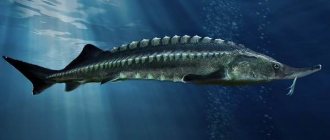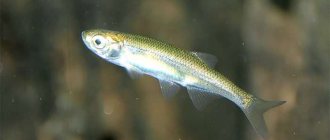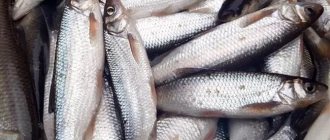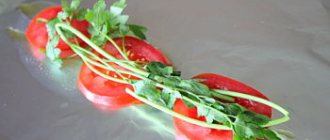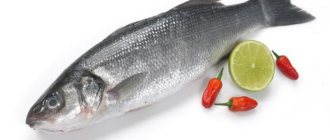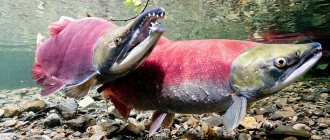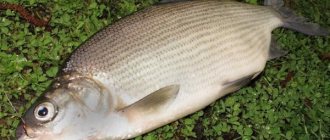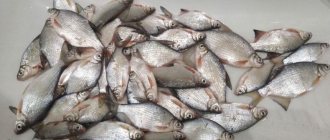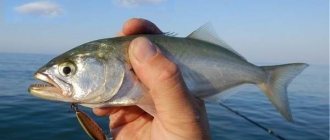Sculpin Goby
In Russia, two species of sculpin are found in continental waters: the spotted sculpin (lat. cottus poecilopus) and the common sculpin (lat. cottus gobio). Both species are listed in a number of regional Red Books of Russia. The sculpin, like the minnow, has merits for fishing, since its characteristic shape served as a model for the creation of a wobbler often used by trout fishermen for catching brook trout.
Sculpins live in clean, cold, well-oxygenated waters of both mountain and lowland waters where trout are found. They lead a typical lifestyle. During the day they hide under a rock, from where they swim out at night to feed, then return to their favorite place. Unlike other fish, which often change positions, sculpins always stick to one place.
Sculpins are a favorite delicacy of brook, rainbow, Danube trout and brown trout. The sculpin family includes about 60 species found in the Northern Hemisphere and the coast of New Zealand. Three species are found in the Baltic Sea and in nearby waters: the European sculpin, the buffalo goby and the four-horned sculpin.
PROTECTION PERIOD: listed in the Red Book, fishing prohibited SPAWNING: April-June DAILY LIMIT: none MINIMUM SIZE: none WORLD RECORD: not registered
Biology of the sculpin goby
The sculpin goby is found in Western, Central and Eastern Europe from the Pyrenees to the Urals, with the exception of the extreme southern regions - the Apennine Peninsula, the Balkan Peninsula, as well as the southern part of the Black Sea basin. In Scandinavia and the British Isles it lives in the southern part.
Sculpins accompany trout in mountain streams and lowland rivers with fast currents. They can also be found along the shores of lakes. In clear, cold water, wherever there are stones, there is a high probability of their presence. They feed mainly on insect larvae and amphipods, which are found on the rocky bottom. Males are larger than females and grow faster. It takes the sculpin about 5 years to grow to 12 cm. The fish reaches sexual maturity in the second year of life and spawns in a recess protected from the current. The eggs are guarded by the male. The larvae, 6 mm long, hatch after 2 weeks, at a favorable temperature of 15°C. The sculpin typically moves along the bottom by jumping. It is caused by a vestigial swim bladder. This behavior makes it possible to notice and identify the sculpin during the day if it is spooked.
The World of the Sculpin Goby
In the Baltic Sea, they catch large sculpin - a fish with an unusual appearance, which is called the European sculpin and belongs to the sculpin family.
Trout fishermen in Europe are trying to take care of the sculpin population in rivers and lakes, realizing that the continued decline in its numbers can affect the entire ecosystem of water bodies in which trout live. In 2006, the sculpin was voted fish of the year in Germany and Austria because its presence in a body of water indicates good water quality. It is typical for the sculpin to change color depending on its habitat. Individuals living on a light bottom have a brown body, while sculpins living among dark rocks have a body that is almost black. Sculpins are sensitive to water purity. They are also found high in the mountains, even above the upper range of brook trout.
The spotted sculpin differs from the common sculpin in the following external characteristics: it has a wider mouth, a flatter head and regular stripes on the body and ventral fins.
In Central European countries, where the sculpin is not protected, fishermen use it as a dead fish when fishing with spinning rods using various tackles.
There are several types of goby fish
Goby fish Sandpiper. It lives in the Black and Azov Seas, in rivers with a sandy bottom. Habitat density up to 50 pieces per 1 sq. meter. Body length up to 20 cm, weight up to 200 g. The body is short, the head is small. Fins without bright color. The color is light and yellowish.
Goby fish Shirman (gorlac). Lives in the Dniester, Berezan and Dnieper-Bug estuaries. In the lakes of the Danube and the Sea of Azov. The body of these gobies is elongated, the scales are firmly attached to the body. The head is flattened, there are two fins on the back. The lower jaw is longer than the lower jaw. The body color is gray, with light blue spots on the sides. The fins have blue stripes. Males have constant coloration. Adapts well to living in silty and hard soils. It is an industrial type. Fishermen on the Black Sea catch it well.
Goby fish Knut (martovik). Distributed in the Black, Caspian and Azov Seas. Goby fish live on rocky bottoms. Body length up to 40 cm, weight up to 500 g. The body is strong, elongated, with a large head. Big mouth. It differs from other gobies in having large gills. When fully opened, it uses its gills to scare away other fish. The color is brown with spots on the sides. It feeds mainly on small fish. There are large sizes up to 1.5 kg and a length of 50 cm.
Goby fish Kruglyak (kutsak). Distributed in the Black, Caspian and Azov Seas. Lives in salt and fresh waters. Body length up to 30 cm, weight up to 250 g. Stocky body, covered with scales, flat tail. The mouth is not big. The coloring is different. It can be brown, light gray, black. It differs from other gobies by its black spot with a yellow border. The head is darker than the body, the fins are gray. Found in the Moscow River and the Baltic Sea. In the south, they are massively caught together with anchovy and sprat.
Goby fish Rotan. Fish of the firebrand family. Body length up to 30 cm, weight up to 300 g. The body is long, narrow, the head is large. Hence the nickname rotan-firebrand. But lately fishermen have not liked it. It eats fry and all living things, preventing crucian carp from developing. Came into our water bodies from the Far East. It develops well in small reservoirs, where it feels like a complete master. A very active predator. In them it can grow to large sizes. In large bodies of water, its harmful activity in destroying juveniles is not so noticeable. It bites on all baits. Swallows immediately and deeply. It's just almost impossible to pull out the hook. Rotan is not caught commercially.
Golovach goby fish (grandmother). The bighead goby lives in the Dniester, Dnieper, Volga, and Bug. Found in the Black, Caspian and Azov Seas. Body length up to 20 cm, weight up to 200 g. The head is flattened, the lip is greatly expanded on the sides. Conical long body. The scales are small. The body is brown with shades of gray and red. With dark spots, the tail has a triangular spot.
Goby fish Sculpin. Fish of the sculpin family. Body length up to 30 cm, weight up to 300 g. Body color is dark, almost black. The body is long, thickened. There is a spine on the back of the gills. It hunts by hiding in a hole with one head sticking out. Not commercially caught.
Goby fish Travnik. The body length of bulls is up to 10 cm, weight up to 100 g. The body is long, uniform along its entire length. Distributed in the west of the Black Sea and the Dnieper Reservoir. Sometimes caught by fishermen.
Goby fish Tsutsik. This goby is widespread in the fresh waters of the Black and Caspian Seas. A small fish up to 7 cm long. It is of interest to aquarists. Body color is marbled. On the muzzle there are two antennae-like appendages. Lives in thickets. Feeds on small invertebrates. Almost never caught.
Goby fish Messenger. The body length of these bulls is up to 20 cm, weight up to 150 g. The body is slender and roundish. With small scales. Color grey-green. there are dark spots. The lower jaw is longer than the lower jaw. The mouth is always slightly open and has teeth. Constantly lives in burrows or under stones. Not commercially caught.
Goby fish are very beautiful and tasty fish.
Common sculpin
Common sculpin (Coitus gobio)
The common sculpin has a completely naked (individual spines are found under the pectoral fins and extremely rarely on the body), low body, sloping towards the tail. A clearly visible long lateral line runs in the middle of the side. The head is very large, wide and flattened, with a small lipped mouth. There are two dorsal fins, the pectoral fins are very wide, and the pelvic fins are small and short. The color of the common sculpin is very modest - grayish or light brown, brown or greenish, with dark spots. Numerous dark stripes and spots
Sculpin fish: how did it get its name?
A sculpin is a small fish with brownish-yellowish tints.
Its body length does not exceed 10 cm, the average size of an adult varies between 4.6-9.8 cm with a body weight from 2 to 45 g.
As its name suggests, the fish leads a sedentary, bottom-dwelling lifestyle. The main food for the sculpin are living organisms of zoobenthos. These can be chironomid and caddisfly larvae, mayflies and stoneflies, and even minnow fish. The habitat of this fish is only fresh, clean waters.
Common sculpin (Cottus gobio).
The main difference between the sculpin and other bottom-dwelling fish is its large, flat head. Each side of it has a powerful, slightly curved pincer in the form of a weapon. Red eyes and a practically naked body make it easy to distinguish the sculpin from other small fish. The dorsal part of the body of the Siberian sculpin has a grayish color with a large number of dark spots.
Close-up of a common sculpin.
All spots and specks merge into wide stripes. The abdomen is yellowish in color without stripes or spots. The living conditions of this species of bottom fish largely influence its appearance. Therefore, you can often observe such a species as the narrow-mouthed goby. It has a narrow head, a small mouth, but a wide part of the tail end. Also found in nature is a variegated goby that has long fins on its belly with a large number of stripes in this part of the body. According to the observations of the famous ichthyologist Blanchard, in adulthood gobies become much darker than young individuals. Males are characterized by having a larger head, but the body is always larger in females.
The sculpin will lead a secretive and measured lifestyle.
The largest representatives of the family are found in the Chusov and Beloozersky reservoirs. The main habitats of sculpins are many rivers in Europe, in its main northern part.
They are also widespread in Western Siberia. The strange thing is that the sculpin is not found anywhere in the Trans-Ural region, although in the western region of the Urals its population is large.
Sculpins are inhabitants of exceptionally clean fresh waters.
Gobies live in large numbers only in clean water, so they are extremely rare in river mouths. On the territory of Turkmenistan, it lives in the flowing waters of the Chirchik River. Almost never found in Russia. In Western Europe, the goby is considered the main enemy of trout caviar. The sculpin prefers stones as housing and sometimes digs holes in the sand. This is where the Russian name for this fish came from – pechkur.
Europeans consider the sculpin an enemy to trout eggs.
Despite the fact that the goby is a bottom fish, it does not live at great depths. Most often they live in shallow places and bodies of water. This is not a schooling fish; they always live alone. The sedentary lifestyle of the sculpin does not allow it to travel long distances, but thanks to its developed pelvic fins it is a very capable hunter at short distances. Due to its hidden and sedentary lifestyle, this fish has no enemies. In very rare cases, a goby can become food for trout. At the same time, the sculpin itself has a good appetite and eats not only crustaceans, beetle larvae and dragonflies, but can also feast on the eggs of frogs and various fish. Particularly larger representatives of the goby can also hunt small minnows and minnows, which often live in the neighborhood.
In our country this fish is called pechkur.
The mating season of the sculpin has been little studied by scientists. But it is known that they dig holes for this. This work is always done by males. Sculpin spawning begins at the end of spring, all this time the males carefully protect their females. There are cases when larger and stronger males even eat their rivals. In recesses prepared in advance, the female lays from 100 to 300 eggs, which are immediately fertilized by the male. The mission of the female individual ends here. The first larvae hatch after 4-5 weeks. All this time, the male remains nearby, waiting for the young to appear, and does not allow anyone near the laying site.
If you find an error, please select a piece of text and press Ctrl+Enter.
Appearance
So, let's start our conversation about the common sculpin with a description of the body structure. This small fish grows to a maximum of 10-12 centimeters in length. The creature has a massive head with a wide jaw. The sculpin's eyes are bulging and large. The body has no scales. However, some areas of bare skin are covered with spines, which provide passive protection from predators.
The common sculpin, a photo of which can be seen in the article, has long pectoral fins. The endings of the latter, like the gill covers, contain sharp projections.
The body of the fish is yellow-gray with brown spots. The abdomen is white. The color also has greenish areas. Thanks to the combination of such shades, an excellent camouflage is formed, which makes the common sculpin unnoticeable to a predator.
Habitats
Sculpins are widespread throughout Europe, Asia and North America. Fish prefer clean lakes, fast-moving rivers, as well as small streams where there is a fast current. Representatives of the species live mainly in reservoirs with rocky bottoms. The species needs an abundance of oxygen and low ambient temperatures. Therefore, these fish prefer to leave warm bodies of water.
General information about fish
This small fish is also called broadhead or sculpin goby. This unique fish belongs to the species of ray-finned fish, representing the slingshot family. Due to its appearance, the sculpin is confused with an ordinary goby, although in fact they are completely different fish.
It should be noted that there are several subspecies of sculpins, such as:
- Speckled sculpin.
- Siberian sculpin.
- Sandy broadhead.
- Chersky's sculpin.
- Sakhalin sculpin.
- Amur broadhead.
- Slimy Sculpin.
This fish grows quite slowly, reaching a length of no more than 5 centimeters after 3 years of life, with a weight of several grams. Life expectancy is about 10 years.
Appearance
It can grow up to 20 centimeters in length. It has a relatively large head, which is somewhat wider than the body itself. It is distinguished by a large mouth and massive lips, as well as large eyes with a red tint. There are no scales on the body, but to protect against enemies, small but quite sharp spikes are placed throughout the body. In this regard, few predators will dare to feast on such prickly prey.
It has elongated pectoral fins covered with small dark spots. In the area of the gills there are protective scutes covered with the same prickly spines. The sculpin's back is gray-yellow with brown spots and stripes. This allows the fish to remain unnoticed against the background of stones, which is an effective protection against its natural enemies.
Habitats
This small fish inhabits fresh water bodies of Europe, Asia and North America, which are located at an altitude of several meters above sea level. At the same time, only reservoirs with clean water and a high concentration of oxygen are suitable for sculpin habitat. Areas with a rocky bottom are more suitable for it, where it is perfectly camouflaged due to its unique coloring.
Lifestyle
This small fish is found within sea bays, where fresh water predominates. Can live in small rivers with rocky bottoms. As a rule, he leads a solitary lifestyle. Prefers to stick to permanent habitats without moving long distances.
During the daytime it hides among scatterings of stones, which is why it got its name as the sculpin. With the onset of darkness, the fish leaves its shelter and goes hunting in search of food. It is almost impossible to notice a fish in the water, since it has the appropriate coloring, merging with the color of the bottom. This fish is considered quite lazy because it swims little, being practically motionless. At the same time, when she is in danger, she can quickly move, although not far, to the nearest shelter. Sculpin is included in the diet of trout.
Usually, within a reservoir, this fish can be found in the area of rifts, in shallow areas. During spawning periods, it quite fiercely protects its living space and offspring.
sculpin
Reproduction
Somewhere in the 4th or 5th year of life, the sculpin can already spawn. At the same time, there are many fewer females than males, which leads to great competition among males.
Depending on the nature of the reservoir and its geographical location, the spawning period takes place at the end of April or beginning of May.
Before the spawning process, each male prepares a place by digging a small hole for the female to lay her eggs there. At the same time, males actively protect their territory from unwanted guests. As a rule, during this period one can observe entire “fights” between males, both for territory and for females.
At one time, the female lays no more than 3 hundred eggs. At the same time, the eggs are distinguished by a yellowish-pink hue and relatively large sizes.
During the spawning period, the female can lay several clutches in the prepared holes of different males, after which the males actively protect the clutch until the fry appear. After 3-4 weeks, fry may appear, although much depends on temperature conditions. The female lays eggs under a stone, gluing them to it. After this, the male takes care of them, removing dust, dirt and debris, constantly fanning them with his fins.
What does the sculpin eat?
This fish has a very varied diet, so it prefers:
- Beetle larvae.
- Caviar of other fish.
- Frog spawn.
- Tadpoles.
- Fry of other fish.
- Dragonfly larvae.
The sculpin prefers the fry of fish such as minnows, trout or sticklebacks. At the same time, he is considered an excellent and intelligent hunter. Before catching prey, this fish additionally camouflages itself. It sinks to the bottom and raises turbidity, which falls on the sculpin and further camouflages it. When it detects potential prey, it rushes at it and swallows it in an instant.
Lifestyle
The common sculpin is a fish that likes to stay away from other creatures. Representatives of the species choose a certain territory, which they zealously protect from the encroachments of their relatives. Fishes lead a solitary lifestyle. They migrate over short distances subject to a radical change in environmental conditions.
In the daytime, the common sculpin prefers to hide under stones, merging with the substrate. With the onset of dusk, it begins to forage for food. The fish is quite lazy. The sculpin swims little, trying to wait for prey while remaining motionless. However, at the first danger, it radically changes its behavior, developing enormous speed in a matter of moments. True, the sculpin swims not far away. The nearest stone or depression in the ground usually becomes a new hiding place for the fish.
The common sculpin is a skilled hunter. Before lying in ambush, waiting for potential prey to approach, the predatory fish stirs up the water with its powerful pectoral fins. Clouds of silt that rise from the bottom cover the body of the sculpin and at the same time attract the attention of other creatures. As soon as the prey approaches such cover, the predator makes a lightning-fast lunge with its wide mouth.
Security status
The common sculpin is included in the Red Book. The species belongs to fish that require cold, clean, oxygenated water to survive. These miniature creatures do not survive well when water bodies are clogged and when heat sets in. Since nowadays rivers are often polluted by waste from industrial enterprises, the number of sculpin has decreased significantly.
It is worth noting that populations of the species are recovering extremely slowly. Sculpins are capable of returning to the previous number of individuals in a particular territory if optimal environmental conditions are maintained for several seasons. Circumstances like this are quite rare. That is why the species is gradually dying out and is protected by the Red Book.
Living conditions
As already mentioned, there are about two thousand species of gobies worldwide. These include jumping fish that live in mango thickets, and the neon goby (cleaner), which rids large fish of parasites. Some species differ from each other only in color, shades and scales.
We are talking about one of the many species of fish that inhabit the waters of the Black and Azov Seas. These are gobies - fish that have lived in these seas since time immemorial, when the Black and Caspian seas were one. Note that in the Black Sea there are about ten species, and in the Sea of Azov - approximately twenty.
Gobies are divided into two main groups:
- brackish water;
- marine.
Brackish water gobies include species that have lived in the Black Sea since time immemorial. They are perfectly adapted to life in the salty waters of estuaries with varying salinity. Marine species originally lived in the Mediterranean Sea. The green goby fish moved from Mediterranean waters to the Black Sea. It gradually adapted to the salinity of the water, and its quantity reached commercial sizes.
The division into sea and river species of gobies is also arbitrary. For example, round gobies and sandpipers have spread along the Dnieper, although previously they lived only in the Black Sea. The river tsutsik goby fish, whose habitat is the Don, was found in small quantities in the Sea of Marmara. But it should be noted that the salinity of the water in it is twice as high as in the Black Sea. This species did not like this, and it began to populate the rivers flowing into the Sea of Marmara.
Reproduction
The mating season for the sculpin begins in March. Males prepare in advance for reproduction by creating a small hole in the soil. Here males wait for females. At the same time, sculpins often enter into battle with other representatives of the species, zealously defending such a unique nest.
After fertilization, the female lays several hundred eggs in the hole and then swims away. The male remains in place, protecting future offspring. The maturation of the embryos in the eggs continues for a month. During this period, the male periodically clears the clutch of silt, actively working with his fins. As soon as the babies are born, the caring dad immediately leaves the nest.
After birth, young individuals begin to actively search for food. At first, their prey is the eggs of frogs and other fish. Having gained mass, the fry hunt invertebrates.
Economic importance of fish
People do not eat the common sculpin as food, since the fish is small in size and its meat is not tasty. But in nature, the common sculpin plays a very important role in the nutrition of such predatory fish as:
- Pike.
- Perch.
- Burbot.
- Grayling.
In addition, some animals such as otters, minks, mergansers and dippers feed on this fish.
At the same time, the sculpin is common in the northern part of Russia.
Natural enemies
The sculpin is a traditional prey for other, larger predatory fish. Pike and perch like to hunt representatives of the species. Also, the sculpin often becomes prey for grayling and burbot. Some mammals feed on this fish, in particular otters and minks.
As for humans, fishermen prefer to send a sculpin caught in a net or on a hook back into the reservoir. After all, the size of the fish is very small. In addition, sculpin meat has a distinct muddy aroma. When eaten, the fish is not very tasty.
Keeping in an aquarium
The sculpin is extremely rarely kept in aquarium conditions. This is primarily due to the poor survival rate of the fish at the slightest change in environmental conditions. In order for a small predator to feel good in captivity, you have to regularly change the water in the aquarium, as well as constantly saturate it with plenty of oxygen. For this, a special injector must be used.
It is necessary to create a shelter for the fish in the aquarium. You can build it from a pile of stones or driftwood. During the first few days, the sculpin may be constantly in the shelter, refusing food. However, having become accustomed and hungry, the predator will greedily pounce on the offered food. As the latter, you can use insect larvae, bloodworms, and earthworms.
Sculpins reproduce quite well in aquarium conditions. The first offspring can be expected within a month after the male and female are placed in an artificial pond. It is advisable to have a minimum number of males in the aquarium. Otherwise, aggressive manifestations and constant struggle for territory cannot be avoided. If the above conditions are met, the sculpin can exist in an aquarium for 5-6 years.
Special status of the common sculpin
This type of fish, which prefers clean waters with a high oxygen content, does not adapt well to heat and water pollution. Due to the fact that rivers are being polluted at a high rate, the number of sculpin is also decreasing. Considering that this fish plays a huge role in the food chain of many fish species, one can only imagine how serious the disappearance of this fish could be.
When the ambient temperature rises, the sculpin leaves or disappears from many bodies of water. The population of this unique fish is recovering very slowly, over several seasons. In this regard, this fish is listed in the Red Book of Russia and is classified as a rare fish species.
Despite some facts, sometimes this fish is caught by amateur fishermen. Due to its amazing coloring, the common sculpin is difficult to notice against the background of the bottom. He can rightfully be called a master of disguise, which often saves his life. But due to the fact that reservoirs are constantly polluted and water temperatures rise above normal, the sculpin is constantly disappearing from many reservoirs.
A sculpin is a small fish with brownish-yellowish tints.
Its body length does not exceed 10 cm, the average size of an adult varies between 4.6-9.8 cm with a body weight from 2 to 45 g.
As its name suggests, the fish leads a sedentary, bottom-dwelling lifestyle. The main food for the sculpin are living organisms of zoobenthos. These can be the larvae of chironomids and caddisflies, mayflies and stoneflies, and even fish. The habitat of this fish is only fresh, clean waters.
The main difference between the sculpin and other bottom-dwelling fish is its large, flat head. Each side of it has a powerful, slightly curved pincer in the form of a weapon. Red eyes and a practically naked body make it easy to distinguish the sculpin from other small fish. The dorsal part of the body of the Siberian sculpin has a grayish color with a large number of dark spots.
All spots and specks merge into wide stripes. The abdomen is yellowish in color without stripes or spots. The living conditions of this species of bottom fish largely influence its appearance. Therefore, you can often observe such a species as the narrow-mouthed goby. It has a narrow head, a small mouth, but a wide part of the tail end. Also found in nature is a variegated goby that has long fins on its belly with a large number of stripes in this part of the body. According to the observations of the famous ichthyologist Blanchard, in adulthood gobies become much darker than young individuals. Males are characterized by having a larger head, but the body is always larger in females.
The largest representatives of the family are found in the Chusov and Beloozersky reservoirs. The main habitats of sculpins are many rivers in Europe, in its main northern part.
They are also widespread in Western Siberia. The strange thing is that the sculpin is not found anywhere in the Trans-Ural region, although in the western region of the Urals its population is large.
Sculpins are inhabitants of exceptionally clean fresh waters.
Gobies live in large numbers only in clean water, so they are extremely rare in river mouths. On the territory of Turkmenistan, it lives in the flowing waters of the Chirchik River. Almost never found in Russia. In Western Europe, the goby is considered the main enemy of caviar. The sculpin prefers stones as housing and sometimes digs holes in the sand. This is where the Russian name for this fish came from – pechkur.
Despite the fact that the goby is a bottom fish, it does not live at great depths. Most often they live in shallow places and bodies of water. This is not a schooling fish; they always live alone. The sedentary lifestyle of the sculpin does not allow it to travel long distances, but thanks to its developed pelvic fins it is a very capable hunter at short distances. Due to its hidden and sedentary lifestyle, this fish has no enemies. In very rare cases, a goby can become food for trout. At the same time, the sculpin itself has a good appetite and eats not only crustaceans, beetle larvae and dragonflies, but can also feast on the eggs of frogs and various fish. Particularly larger representatives of the goby can also hunt small minnows and minnows, which often live in the neighborhood.
What is the common sculpin? What kind of life does a fish lead? Where does he live? What does it eat? How does it reproduce? Answers to these and other questions can be obtained by reading our publication. A description and photo of the common sculpin will be presented below.
